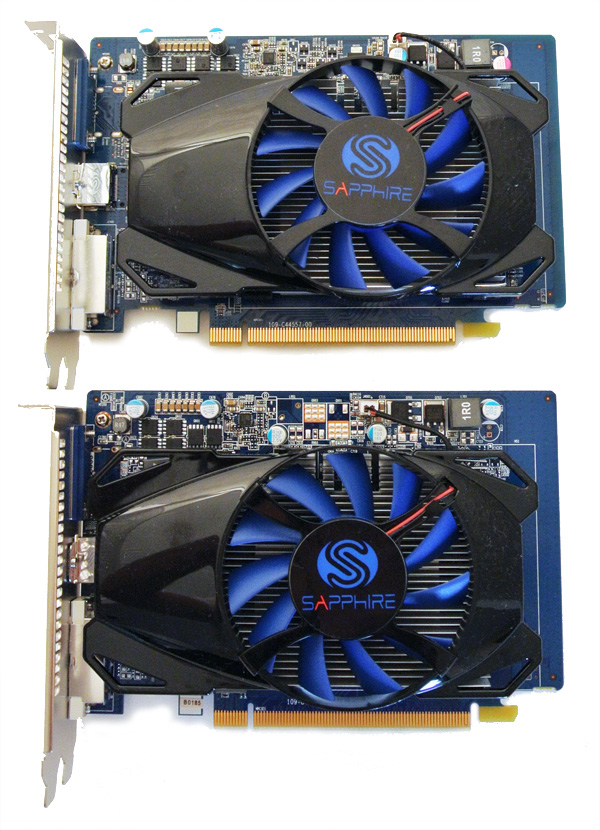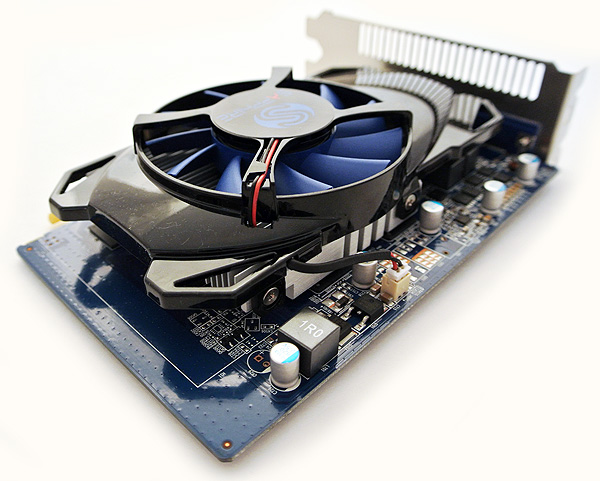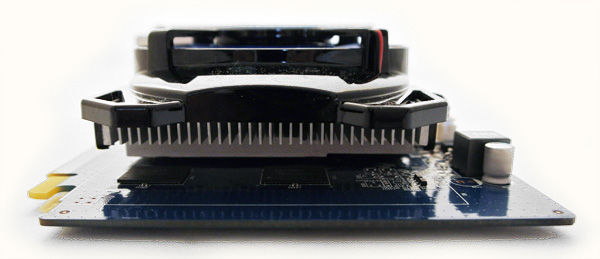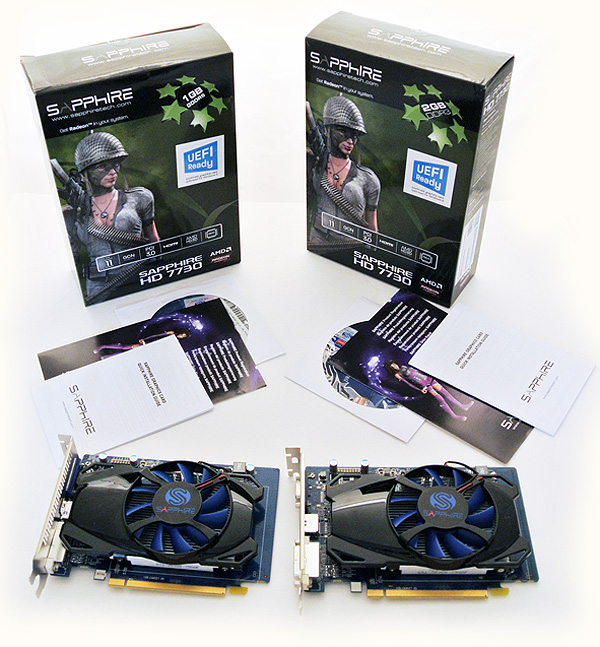AMD Radeon HD 7730 Review: A Harbinger Of The Kaveri APU?
We got our hands on two Radeon HD 7730 cards from Sapphire: one with 2 GB of DDR3 and the other sporting 1 GB of GDDR5. How do they compare to AMD's Radeon HD 6670s, and what might we glean from these boards about the upcoming Kaveri-based APUs?
AMD's Radeon HD 7730: GCN Goes Entry-Level
AMD introduced its Graphics Core Next architecture in the Radeon HD 7970's Tahiti GPU way back in December of 2011. In the 20 months since then, the company's Radeon HD 7750 was the lowest-end model based on GCN. Below that, you'll find older VLIW5-based Radeon HD 6670, 6650, and 6450 boards. Those cards have been around so long that OEMs are rebadging the Radeon HD 6670 as a 7670 just so it sounds new. Bleh.
But AMD recently (and quietly) started shipping a new entry-level Radeon HD 7730 in Asia. Then, it started trickling into Europe. According to Sapphire, you'll soon see it in the U.S. as well.
Although a budget-oriented board centering on GCN isn't going to elevate anyone's heart rate, we really want to see how it compares to the Radeon HD 6600-series cards. More significantly, perhaps, the Radeon HD 7730 may give us a glimpse of AMD's next-generation APU, code-named Kaveri, which my not show up until early 2014.
There's a lot of misinformation floating around about the 7730's GPU, so we cleared things up with AMD to get you a more accurate depiction of its Cape Verde LE graphics processor.
We're not surprised that the Radeon HD 7730 comes armed with a cut-down version of the Cape Verde GPU found in AMD's Radeon HD 7750 and 7770. Both mid-range models have been around for quite a while, and it makes sense that the company would sort its chips to put the imperfect ones to use. The 7730's specifications are also typical of AMD's sub-$100 line-up. Two of Cape Verde's four render partitions are disabled, leaving eight full-color ROPs per clock. An aggregate 128-bit memory interface remains. The GPU has six of its 10 compute units turned on, each hosting 64 ALUs and four texture units, adding up to 384 shaders and 24 total texture units.
Before you try too hard to compare the number of shaders, texture units, ROPs, and memory bandwidth to AMD's Radeon HD 6670, remember that both GPUs leverage different architectures. So, while the 7730 comes up short against the 6670's shader count, we aren't expecting it to be slower. In fact, it should be more efficient, using less power for comparable performance.
When it comes to clock rates, the Radeon HD 6670 and 7730 share the same 800 MHz core frequency. The DDR3 versions of both cards employ 900 MHz memory, while the GDDR5 model of the Radeon HD 7730 enjoys a 125 MHz advantage over the 6670's 1 GHz setting. At the same time, the Radeon HD 7730 GDDR5 is specified for a 17 W-lower TDP than the Radeon HD 6670 GDDR5.
Get Tom's Hardware's best news and in-depth reviews, straight to your inbox.
| Header Cell - Column 0 | GeForce GT 640DDR3 | Radeon HD 6670 | Radeon HD 7730 | Radeon HD 7750 |
|---|---|---|---|---|
| Shader Cores | 384 (Kepler) | 480 (VLIW5) | 384 (GCN) | 512 (GCN) |
| Texture Units | 32 | 24 | 24 | 32 |
| Color ROPs | 16 | 8 | 8 | 16 |
| Fabrication process | 28 nm | 40 nm | 28 nm | 28 nm |
| Core (Shader) Clock | 900 MHz | 800 MHz | 800 MHz | 800 MHz |
| Memory Clock | 891 MHz DDR3 | 900 MHz DDR3 900-1000 MHz GDDR5 | 900 MHz DDR31125 MHz GDDR5 | 1125 MHz GDDR5 |
| Memory Bus | 128-bit | 128-bit | 128-bit | 128-bit |
| Memory Bandwidth | 28.5 GB/s DDR3 | 28.8 GB/s DDR3 64 GB/s GDDR5 | 28.8 GB/s DDR372 GB/s GDDR5 | 72 GB/s |
| Idle/Max Thermal Design Power | 15/65 W | 10/44 W DDR311/60 W GDDR5 | 47 W | 55 W |
| Price | $80-$140 (Newegg) | $60-$80 DDR3$75-$98 GDDR5 (Newegg) | ~$69 1 GB GDDR5~$79 2 GB DDR3 (MSRP) | $90-$155 (Newegg) |
Based on its specifications, we're thinking that the Radeon HD 7730 will probably perform a lot like the Radeon HD 6670 with the same memory technology on-board. That means it will do battle in the space underneath AMD's $90 Radeon HD 7750.
The competing Radeon HD 6670 GDDR5 and GeForce GT 640 show up too close to the superior 7750, so we have to hope the 7730 starts in the $60 range. Right now, that's what AMD is asking for its Radeon HD 6670 DDR3, which we consider to be the best entry-level discrete card.
Sapphire HD 7730 DDR3 and GDDR5
Sapphire sent us two Radeon HD 7730s to test. One is equipped with 2 GB of 900 MHz DDR3 and the second has half as much GDDR5 memory operating at 1125 MHz. Measuring 6.5"x4.25", both PCBs are the same size as AMD's reference Radeon HD 7750, although Sapphire employs a beefier dual-slot cooling solution. The two samples actually look pretty similar from up top; really, the biggest differences are down on the board.
The boards also look alike from the back, though you can see the 2 GB model's extra DDR3 memory up top.
Both of Sapphire's Radeon HD 7730 cards feature dual-link DVI, HDMI, and VGA outputs. It's unfortunate that you don't get DisplayPort connectivity, which you'd want for a three-screen Eyefinity setup.
The 7730's 47 W TDP falls well below a 16-lane PCI Express slot's 75 W ceiling, so you don't need an auxiliary power input.
Sapphire's Dual-X cooler is equipped with a single 75 mm axial fan, and the cooing block is solid aluminum with no heat pipes.
AMD doesn't arm these cards with a physical bridge connector for CrossFire, though the multi-GPU technology is purportedly supported via software.
Given an entry-level target, you don't get much bundled with these cards: a driver CD, quick installation card, and Sapphire's registration card. There are three different output connectors, so adapters really aren't necessary anyway. And although this a Radeon HD 7700-series product, we're told that these low-budget boards do not qualify for AMD's Never Settle game bundle.
Current page: AMD's Radeon HD 7730: GCN Goes Entry-Level
Next Page Test Setup And BenchmarksDon Woligroski was a former senior hardware editor for Tom's Hardware. He has covered a wide range of PC hardware topics, including CPUs, GPUs, system building, and emerging technologies.
-
rmpumper Just look at that performance difference between DDR3 and GDDR5. AMD sure needs to implement GDDR5 in Kaveri in order not to waist all that GPU potential.Reply -
designasaurus Reply11292234 said:Just look at that performance difference between DDR3 and GDDR5. AMD sure needs to implement GDDR5 in Kaveri in order not to waist all that GPU potential.
Your comment, while being perfectly accurate, actually made me notice something interesting. Take a look at the charts, and you'll see that the GCN 7730s are less affected by the switch from DDR3 to GDDR5 than the VLIW 6670s! That means GCN is leaving less performance on the table if it's paired with slower memory, which is ideal for the situation an APU is usually in (PS4 aside). -
Onus At the right price, this looks like a real winner, especially the GDDR5 version. If a $90 HD7750 is too rich, an HD7730 for $65 looks like it is still capable of playing most games, especially at 720p resolutions where a lot of HTPC cards operate.Reply
The "secret sauce" that could really catapult this one would be if some of its disabled pieces might be able to be switched on.
-
ET3D Regarding Kaveri, it looks from this that CGN means better performance with DDR3, but also higher power consumption. If AMD wants to keep to the same power envelope it might have to reduce GPU clock speeds, which will eat into the performance advantage. In the end, it feels from this that Kaveri will offer only a minor performance boost.Reply
Hopefully AMD has done more power optimisations and that won't be the case. -
shikamaru31789 I'm a little dissapointed if this is what we can expect from Kaveri. I was hoping for something that would come closer to matching the APU in the Xbox One. I want to build a small HTPC for gaming in my living room, and an APU would have been ideal for that since the smaller HTPC cases don't have room for large discrete graphics cards. I don't know, maybe Kaveri could still be useful if they actually get Hybrid Crossfire working properly, a Kaveri APU paired with a discrete 7730 and DDR3 2133 might just work out for my purposes.Reply -
slomo4sho I don't see why manufacturers continue to utilize this ram in newer products... Just get rid of DDR3 already...Reply
Also, how is this Cape Verde GPU a "Harbinger Of The Kaveri APU"? It is a trimmed down 7750 and since a 7750 can provide no real insight into the performance of upcoming Kaveri APUs then how does this entry level card provide any better insight? -
army_ant7 On page 10, does the reference HD 7750 really have a load temp of 97C?Reply
(73C + 24C ambient = 93C)
Anyway, the GDDR5 HD 7750 looks like a viable game-enabler for PC gamers on a budget. Also, it's a nice refresh for that price point's options. I do hope it sells for around $60 or less. :-D -
sarinaide Reply11292661 said:I'm a little dissapointed if this is what we can expect from Kaveri. I was hoping for something that would come closer to matching the APU in the Xbox One. I want to build a small HTPC for gaming in my living room, and an APU would have been ideal for that since the smaller HTPC cases don't have room for large discrete graphics cards. I don't know, maybe Kaveri could still be useful if they actually get Hybrid Crossfire working properly, a Kaveri APU paired with a discrete 7730 and DDR3 2133 might just work out for my purposes.
I have found a Trinity based APU more than enough for a HTPC. I would not have banked on Kaveri matching the XB1 and PS4's custom build silicon as in the name the APU designed for MS and Sony was of custom design and the hardware was always going to scale beyond that for desktop parts. If you offered me HD7730-7750 performance on a Kaveri I would be very pleased with that. What hasn't been brought to light is that the Spectre IGPU on Kaveri features around 512 Stream Processors and increased ROP's and compute units so it may very well be a potent iGPU.
Dual Graphics has improved with Catalyst 13.8 to the point it is now playable, if a Richland can DG with the HD7730's that would be tremendous fo gaming under $200 for chip and card.






